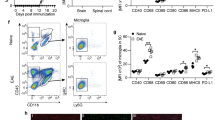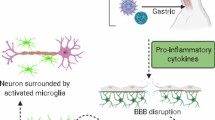Abstract
Molecular diversity within brain-derived HIV-1 sequences is highly variable depending on the individual gene examined and the neurological status of the patient. Herein, we examined different brain-derived human immunodeficiency virus (HIV)-1 tat sequences in terms of their effects on LTR transactivation and host gene induction in neural cells. Astrocytic and monocytoid cells co-transfected with prototypic tat clones derived from non-demented (ND) (n = 3) and demented (HAD) (n = 3) AIDS patients and different HIV-LTR constructs revealed that LTR transactivation mediated by tat clones derived from HAD patients was decreased (p < 0.05). A Tat-derived peptide containing the amino acid 24–38 domain from a ND clone caused down-regulation of the LTR transactivation (p < 0.05) in contrast to peptides from other Tat regions derived from HAD and ND tat clones. Both brain-derived HAD and ND tat constructs were able to induce the host immune genes, MCP-1 and IL-1β. Microarray analysis revealed several host genes were selectively upregulated by a HAD-derived tat clone including an enzyme mediating heparan sulphate synthesis, HS3ST3B1 (p < 0.05), which was also found to be increased in the brains of patients with HAD. Expression of the pro-apoptotic gene, PDCD7, was reduced in cells transfected with the HAD-derived tat clone and moreover, this gene was also suppressed in monocytoid cells infected with a neurotropic HIV-1 strain. Thus, mutations within the HIV-1 tat gene may exert pathogenic effects contributing to the development of HAD, which are independent of its effects on LTR transactivation.
Similar content being viewed by others
References
Aldovini A, Feinberg MB (1990). Techniques in HIV research. Stockton Press: New York.
Andreoni M (2004). Viral phenotype and fitness. New Microbiol 27: 71–76.
Bannwarth S, Gatignol A (2005). HIV-1 TAR RNA: the target of molecular interactions between the virus and its host. Curr HIV Res 3: 61–71.
Biswas DK, Salas TR, Wang F, Ahlers CM, Dezube BJ, Pardee AB (1995). A Tat-induced auto-up-regulatory loop for superactivation of the human immunodeficiency virus type 1 promoter. J Virol 69: 7437–7444.
Boven LA, Gomes L, Hery C, Gray F, Verhoef J, Portegies P, Tardieu M, Nottet HS (1999). Increased peroxynitrite activity in AIDS dementia complex: implications for the neuropathogenesis of HIV-1 infection. J Immunol 162: 4319–4327.
Boven LA, Vergnolle N, Henry SD, Silva C, Imai Y, Holden J, Warren K, Hollenberg MD, Power C (2003). Up-regulation of proteinase-activated receptor 1 expression in astrocytes during HIV encephalitis. J Immunol 170: 2638–2646.
Boykins RA, Mahieux R, Shankavaram UT, Gho YS, Lee SF, Hewlett IK, Wahl LM, Kleinman HK, Brady JN, Yamada KM, Dhawan S (1999). Cutting edge: a short polypeptide domain of HIV-1-Tat protein mediates pathogenesis. J Immunol 163: 15–20.
Brack-Werner R (1999). Astrocytes: HIV cellular reservoirs and important participants in neuropathogenesis. Aids 13: 1–22.
Bratanich AC, Liu C, McArthur JC, Fudyk T, Glass JD, Mittoo S, Klassen GA, Power C (1998). Brain-derived HIV-1 tat sequences from AIDS patients with dementia show increased molecular heterogeneity. J Neurovirol 4: 387–393.
Burdo TH, Nonnemacher M, Irish BP, Choi CH, Krebs FC, Gartner S, Wigdahl B (2004). High-affinity interaction between HIV-1 Vpr and specific sequences that span the C/EBP and adjacent NF-kappaB sites within the HIV-1 LTR correlate with HIV-1-associated dementia. DNA Cell Biol 23: 261–269.
Chen P, Mayne M, Power C, Nath A (1997). The Tat protein of HIV-1 induces tumor necrosis factor-alpha production. Implications for HIV-1-associated neurological diseases. J Biol Chem 272: 22385–22388.
Conant K, Garzino-Demo A, Nath A, McArthur JC, Halliday W, Power C, Gallo RC, Major EO (1998). Induction of monocyte chemoattractant protein-1 in HIV-1 Tat-stimulated astrocytes and elevation in AIDS dementia. Proc Natl Acad Sci USA 95: 3117–3121.
Conant K, Ma M, Nath A, Major EO (1996). Extracellular human immunodeficiency virus type 1 Tat protein is associated with an increase in both NF-kappa B binding and protein kinase C activity in primary human astrocytes. J Virol 70: 1384–1389.
Darbinian N, Sawaya BE, Khalili K, Jaffe N, Wortman B, Giordano A, Amini S (2001). Functional interaction between cyclin T1/cdk9 and Puralpha determines the level of TNFalpha promoter activation by Tat in glial cells. J Neuroimmunol 121: 3–11.
Dayton AI, Sodroski JG, Rosen CA, Goh WC, Haseltine WA (1986). The trans-activator gene of the human T cell lymphotropic virus type III is required for replication. Cell 44: 941–947.
Gatignol A, Duarte M, Daviet L, Chang YN, Jeang KT (1996). Sequential steps in Tat trans-activation of HIV-1 mediated through cellular DNA, RNA, and protein binding factors. Gene Expr 5: 217–228.
Genois N, Robichaud GA, Tremblay MJ (2000). Mono Mac 1: a new in vitro model system to study HIV-1 infection in human cells of the mononuclear phagocyte series. J Leukoc Biol 68: 854–864.
Gonzalez-Scarano F, Martin-Garcia J (2005). The neuropathogenesis of AIDS. Nat Rev Immunol 5: 69–81.
Gorman CM, Moffat LF, Howard BH (1982). Recombinant genomes which express chloramphenicol acetyltransferase in mammalian cells. Mol Cell Biol 2: 1044–1051.
Hofman FM, Dohadwala MM, Wright AD, Hinton DR, Walker SM (1994). Exogenous tat protein activates central nervous system-derived endothelial cells. J Neuroimmunol 54: 19–28.
Huigen MC, Kamp W, Nottet HS (2004). Multiple effects of HIV-1 trans-activator protein on the pathogenesis of HIV-1 infection. Eur J Clin Invest 34: 57–66.
Johnston JB, Silva C, Gonzalez G, Holden J, Warren KG, Metz LM, Power C (2001a). Diminished adenosine A1 receptor expression on macrophages in brain and blood of patients with multiple sclerosis. Ann Neurol 49: 650–658.
Johnston JB, Silva C, Holden J, Warren KG, Clark AW, Power C (2001b). Monocyte activation and differentiation augment human endogenous retrovirus expression: implications for inflammatory brain diseases. Ann Neurol 50: 434–442.
Johnston JB, Zhang K, Silva C, Shalinsky DR, Conant K, Ni W, Corbett D, Yong VW, Power C (2001c). HIV-1 Tat neurotoxicity is prevented by matrix metalloproteinase inhibitors. Ann Neurol 49: 230–241.
Kelly GD, Morris CB, Offermann MK (1999). Lack of responsiveness of a nuclear factor-kappaB-regulated promoter to transactivation by human immunodeficiency virus 1 Tat in HeLa cells. Virology 263: 128–138.
Lassen K, Han Y, Zhou Y, Siliciano J, Siliciano RF (2004). The multifactorial nature of HIV-1 latency. Trends Mol Med 10: 525–531.
Liu J, Blackhall F, Seiden-Long I, Jurisica I, Navab R, Liu N, Radulovich N, Wigle D, Sultan M, Hu J, Tsao MS, Johnston MR (2004). Modeling of lung cancer by an orthotopically growing H460SM variant cell line reveals novel candidate genes for systemic metastasis. Oncogene 23: 6316–6324.
Loregian A, Bortolozzo K, Boso S, Sapino B, Betti M, Biasolo MA, Caputo A, Palu G (2003). The Sp1 transcription factor does not directly interact with the HIV-1 Tat protein. J Cell Physiol 196: 251–257.
Marchio S, Alfano M, Primo L, Gramaglia D, Butini L, Gennero L, De Vivo E, Arap W, Giacca M, Pasqualini R, Bussolino F (2005). Cell surface-associated Tat modulates HIV-1 infection and spreading through a specific interaction with gp120 viral envelope protein. Blood 105: 2802–2811.
Mayne M, Bratanich AC, Chen P, Rana F, Nath A, Power C (1998). HIV-1 tat molecular diversity and induction of TNF-alpha: implications for HIV-induced neurological disease. Neuroimmunomodulation 5: 184–192.
Nabel G, Baltimore D (1987). An inducible transcription factor activates expression of human immunodeficiency virus in T cells. Nature 326: 711–713.
Nath A (2002). Human immunodeficiency virus (HIV) proteins in neuropathogenesis of HIV dementia. J Infect Dis 186 Suppl 2: S193-S198.
Nath A, Conant K, Chen P, Scott C, Major EO (1999). Transient exposure to HIV-1 Tat protein results in cytokine production in macrophages and astrocytes. A hit and run phenomenon. J Biol Chem 274: 17098–17102.
Park EJ, Kim JH, Seong RH, Kim CG, Park SD, Hong SH (1999). Characterization of a novel mouse cDNA, ES18, involved in apoptotic cell death of T-cells. Nucleic Acids Res 27: 1524–1530.
Patel M, Yanagishita M, Roderiquez G, Bou-Habib DC, Oravecz T, Hascall VC, Norcross MA (1993). Cell-surface heparan sulfate proteoglycan mediates HIV-1 infection of T-cell lines. AIDS Res Hum Retroviruses 9: 167–174.
Peruzzi F, Gordon J, Darbinian N, Amini S (2002). Tat-induced deregulation of neuronal differentiation and survival by nerve growth factor pathway. J Neurovirol 8 Suppl 2: 91–96.
Power C, Kong PA, Crawford TO, Wesselingh S, Glass JD, McArthur JC, Trapp BD (1993). Cerebral white matter changes in acquired immunodeficiency syndrome dementia: alterations of the blood-brain barrier. Ann Neurol 34: 339–350.
Power C, McArthur JC, Nath A, Wehrly K, Mayne M, Nishio J, Langelier T, Johnson RT, Chesebro B (1998). Neuronal death induced by brain-derived human immunodeficiency virus type 1 envelope genes differs between demented and nondemented AIDS patients. J Virol 72: 9045–9053.
Rappaport J, Joseph J, Croul S, Alexander G, Del Valle L, Amini S, Khalili K (1999). Molecular pathway involved in HIV-1-induced CNS pathology: role of viral regulatory protein, Tat. J Leukoc Biol 65: 458–465.
Roof P, Ricci M, Genin P, Montano MA, Essex M, Wainberg MA, Gatignol A, Hiscott J (2002). Differential regulation of HIV-1 clade-specific B, C, and E long terminal repeats by NF-kappaB and the Tat transactivator. Virology 296: 77–83.
Rossi A, Mukerjee R, Ferrante P, Khalili K, Amini S, Sawaya BE (2006). Human immunodeficiency virus type 1 Tat prevents dephosphorylation of Sp1 by TCF-4 in astrocytes. J Gen Virol 87: 1613–1623.
Silva C, Zhang K, Tsutsui S, Holden JK, Gill MJ, Power C (2003). Growth hormone prevents human immunodeficiency virus-induced neuronal p53 expression. Ann Neurol 54: 605–614.
Tsutsui S, Schnermann J, Noorbakhsh F, Henry S, Yong VW, Winston BW, Warren K, Power C (2004). A1 adenosine receptor upregulation and activation attenuates neuroinflammation and demyelination in a model of multiple sclerosis. J Neurosci 24: 1521–1529.
van der Zee R, Anderton SM, Buskens CAF, Alonso de Velasco E, van Eden W (1994). Heat shock protein T cell epitopes as immunogenic carriers in subunit vaccines. In: Twenty-third European peptide symposium. Maya HLS, (ed): Leiden.
van Marle G, Power C (2005). Human immunodeficiency virus type 1 genetic diversity in the nervous system: evolutionary epiphenomenon or disease determinant? J Neurovirol 11: 107–128.
Wesselingh SL, Power C, Glass JD, Tyor WR, McArthur JC, Farber JM, Griffin JW, Griffin DE (1993). Intracerebral cytokine messenger RNA expression in acquired immunodeficiency syndrome dementia. Ann Neurol 33: 576–582.
Zhang K, McQuibban GA, Silva C, Butler GS, Johnston JB, Holden J, Clark-Lewis I, Overall CM, Power C (2003a). HIV-induced metalloproteinase processing of the chemokine stromal cell derived factor-1 causes neurodegeneration. Nat Neurosci 6: 1064–1071.
Zhang K, Rana F, Silva C, Ethier J, Wehrly K, Chesebro B, Power C (2003b). Human immunodeficiency virus type 1 envelope-mediated neuronal death: uncoupling of viral replication and neurotoxicity. J Virol 77: 6899–6912.
Author information
Authors and Affiliations
Corresponding author
Additional information
LAB was supported by an Alberta Heritage Foundation for Medical Research (AHFMR)/ Canadian Institutes of Health Research (CIHR) Fellowship.
CP holds a Canada Research Chair (T1) in Neurological Infection and Immunity and is an AHFMR Senior Scholar.
These studies were supported by grants from the CIHR (CP) and CANFAR (CP).
Rights and permissions
About this article
Cite this article
Boven, L.A., Noorbakhsh, F., Bouma, G. et al. Brain-derived human immunodeficiency virus-1 Tat exerts differential effects on LTR transactivation and neuroimmune activation. Journal of NeuroVirology 13, 173–184 (2007). https://doi.org/10.1080/13550280701258399
Received:
Revised:
Accepted:
Issue Date:
DOI: https://doi.org/10.1080/13550280701258399




